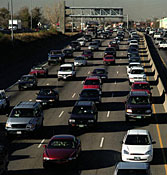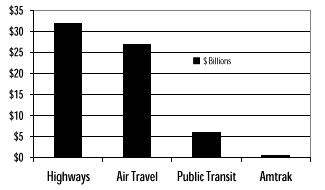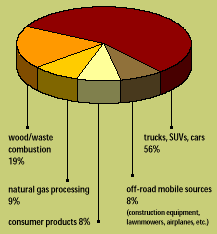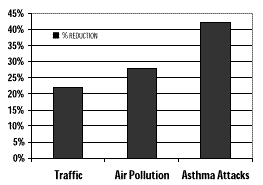 | ||||
"The work-bound traveler of 1950, even 1900, had more
transportation options than does the ultramodern,
cell-phone-equipped millennial commuter of today." As traffic and smog continue to degrade quality of life for millions of Americans, visionary communities are turning to alternative transportation choices, such as modern commuter trains, clean bus lines, vanpools, bike paths and safe sidewalks to improve quality of life. By focusing on moving people rather than autos, these communities are pulling commuters out of traffic jams by giving them more choices in how they get to work. Unfortunately, many of our public officials continue to support an unbalanced approach to transportation planning. Expensive and inefficient transportation projects that offer only a short-term solution receive the lion's share of taxpayer funding. These projects gobble up our farmland and natural open spaces, increase smog, promote poorly planned, sprawling developments, and often increase the traffic problems they are supposed to fix. This map samples some of the best and worst transportation projects in America. From simple community-based initiatives to large-scale projects with billion-dollar budgets, it is a glimpse of what is happening with transportation planning in America. It shows the many different approaches we can take to solve our transportation challenges and the vastly different directions our planning can take us. Transportation Choices Improve Quality of Life Runaway, haphazard development—which brings more roads, more
traffic and more pollution—is not inevitable. One of the best ways
to curb sprawl is through wise transportation planning and
investments. By balancing funding between highways and public
transportation choices, such as rail, buses, bike paths and
sidewalks, we can: Americans Want Better Transportation Choices Spending money on public transportation is a good investment that responds to public demand. Americans are increasingly turning to public transportation. The public wants a clean environment and more public transportation choices—it is up to federal, state and local governments to provide these options. Source: http://www.apta.com/ According to a National Association of Realtors poll conducted by Public Opinion Strategies in September 2001, most commuters are willing to try transportation alternatives if they are convenient, safe and accessible.
More Highways Are Not the Answer to Congestion Recent studies show that building or widening highways invites more traffic, a phenomenon called “induced traffic.” Shortly after the new lanes or road is opened, public transit or carpool riders switch to driving. Motorists decide to take longer and more frequent trips or switch routes to take advantage of the new capacity on the roadway. As the new/expanded roadway stimulates more development away from core cities and suburbs, motorists move farther from work and shopping. Often, induced traffic eats up 50 to 100 percent of the roadway’s new capacity. After a few years, the “new” roadway has once again reached full capacity, and created extra traffic on the local streets at both ends of the trip.
Over-Dependence on Highways Harms Communities Short-sighted transportation planning and investments that rely on highway construction to the neglect of other transportation choices traps people in their cars and pollutes the environment. Over-dependence on highways hurts communities by: Sprawl and lack of transportation choices force people to own and drive cars in order to reach most destinations. The average American driver spends 443 hours per year—the equivalent of 55 eight-hour work days—behind the wheel. Source: 1997 USDOT Report, "Our Nation’s Travel Infrastructure needs arising from sprawling development cost American households an average of $630 per year. Transportation is the second biggest household cost for American families, more than food, education or healthcare.Source: http://www.transact.org/report.asp?id=36 Residents of sprawling communities drive three to four times more than those living in efficient, well-planned areas and can waste up to three to four times more energy from driving than people who live in better-planned, efficient cities that offer more transportation choices. Source: http://www.environmentaldefense.org/ While roadways for autos continue to be expanded, there has not been a corresponding increase in safe and convenient pedestrian walkways, making it more difficult and dangerous for people to walk. Between 1986 and 1995, approximately 6,000 pedestrians were killed each year in the U.S. by automobiles. For every pedestrian killed by a car, another 15 were injured. "Wide roads have been built without sidewalks or frequent crosswalks, and high-speed traffic makes these roadways particularly deadly. In many areas, intersections with crosswalks may be as much as a half-mile apart, leaving pedestrians with no safe way to cross the street." Source: "Mean Streets 2000," Surface Transportation Policy Project, http://www.transact.org/
Unbalanced Transportation Spending Feeds Sprawl and Pollution The federal transportation bill, called the Transportation Equity Act for the 21st Century, appropriates over $217 billion, but it spends five times as much on highways as on public transportation. Air Quality and Transportation Smog is a serious public health threat. Twenty percent of Americans live in areas where doctors and scientists say the air is not safe to breathe. Exposure to smog can trigger or cause a range of illnesses and conditions, from asthma to pneumonia. According to the EPA, over 50 percent of all cancers that are attributed to outdoor air toxics can be traced back to the toxics released from mobile sources such as cars, trucks and SUVs. Our reliance on cars and trucks has led to severe air pollution problems and a significant public health threat. Giving people more transportation choices can dramatically lower automobile use, reducing air pollution and the accompanying effects on public health. Providing more transportation choices during the 1996 Olympics reduced traffic by 22 percent, air pollution by 28 percent and asthma attacks by up to 42 percent.
By better balancing transportation spending between roads and less-polluting public transportation, like rail transit and clean buses, we can reduce the number of miles people have to drive, provide Americans with more transportation choices, and better reflect America’s priorities for a clean environment, good health and enhanced quality of life. In order to protect our communities and clean our air, water and environment, transportation policy should: Press Release This project was made possible through the hard work of many Sierra Club volunteers and staff, including: CHALLENGE TO SPRAWL CAMPAIGN COMMITTEE: Project Coordinator: Neha Bhatt Design: John Byrne Barry This report was funded by a grant from The Sierra Club Foundation. Photo courtesy National Renewable Energy Laboratory. Up to Top | ||||



